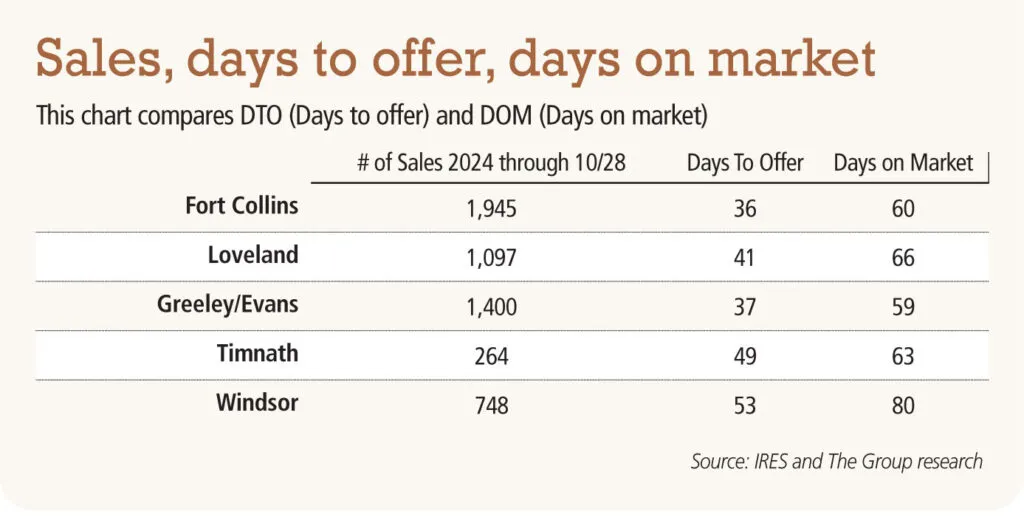Wells: Days to offer a better method to track housing demand

For anyone who wants to assess the level of activity in a local housing market, the most common statistical measure is known as days on market, or DOM, which measures how many days a home is listed for sale before a deal is closed.
However, in Northern Colorado a better measure to gauge buyer demand is days to offer, or DTO. Here’s why:
Locally, our multiple-listing service determines that a home is no longer on the market only after an offer is accepted and both parties have signed a contract. But that formula doesn’t reflect the actual pace of the market.
SPONSORED CONTENT
What about listings for which there is already a contingency contract, but the seller still accepts backup offers? Or what about listings for which the seller has granted a first right of refusal to a would-be buyer — probably because the seller is waiting for the buyer to sell another property before moving forward on the contract — but continues to accept backup offers?
In these instances, there is an offer on the table. But, as you can see in the accompanying chart, there’s a big difference between DTO and DOM.
In Loveland, the average DOM through late October was 66 days, but offers were actually arriving in just 41 days — roughly 38% faster than the DOM data would suggest. Other cities in Northern Colorado are showing similar discrepancies.
In Fort Collins, the average DOM was 60, with offers coming in at 36 days, a difference of 40%. For Greeley, the average DOM was 59 days, compared to 37 for days to offer, or 39% faster. In Windsor, DOM was 80 days, with offers being received in just 53 days, a difference of nearly 34%. And for Timnath, DOM was 63 days while offers were made in an average of 49 days, or 22% faster.
As you can see, there is a major difference in the reported days to offer versus days on market. Be cautious of reading market reports that reflect Days on Market for Northern Colorado markets because they typically pull data that is not an accurate reflection of the time to receipt of an offer.
Here’s a finer grain look at what happens:
When a property goes under contract, it gets placed in one of three categories:
• Active/Backup: An active listing with a contingency contract (still showing to would-be buyers and taking backup offers).
• Active/First Right: An active listing with a first right of refusal (still showing and taking offers).
• Pending: A listing where an offer has been accepted and the listing is no longer on the market. This occurs when there is a mutually executed contract, meaning both parties have signed. No more showings or offers are accepted.
The DOM data only reflects properties that have been added to the “Pending” status. But DTO accounts for all property categories, including Active/Backup, Active/First Right, and Pending, and reflects the number of days a property was in Active status before receiving any offers.
Frankly, using days on market to determine local activity could leave buyers with a misplaced sense of complacency — a belief that competition isn’t quite so strong — or trick sellers into thinking the demand from buyers is not as strong as it actually is.
Bottomline: The DTO figure is important because the speed of the offer is a truer measure of what sellers can expect of buyer demand in Northern Colorado when they list their home for sale. That makes a meaningful impact when you sit down with your Realtor to discuss your pricing strategy.
The chart reflects the difference between days on market statistics and days to offer in five local market areas in Northern Colorado. The figures reflect sales of both single-family detached housing as well as attached (condominiums and townhomes):
Brandon Wells is president of The Group Inc. He can be reached at bwells@thegroupinc.com or 970-430-6463.

For anyone who wants to assess the level of activity in a local housing market, the most common statistical measure is known as days on market, or DOM, which measures how many days a home is listed for sale before a deal is closed.
However, in Northern Colorado a better measure to gauge buyer demand is days to offer, or DTO. Here’s why:
Locally, our multiple-listing service determines that a home is no longer on the market only after an offer is accepted and both parties have signed a contract. But that formula…




